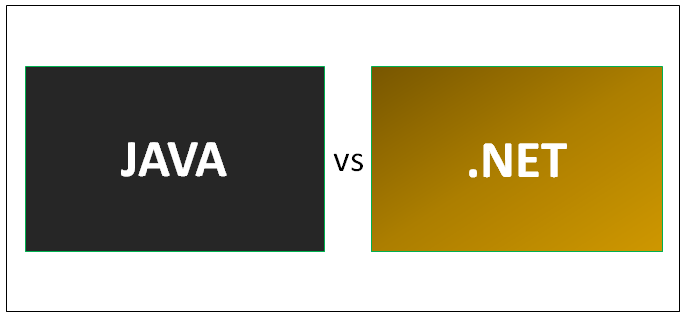TECHNOLOGY
.NET vs. Java

.NET vs. Java
There has been a heated battle between Java developers and .NET developers regarding which platform is better for web development, software development, and other such use cases.
Both .NET and Java are very popular, robust, versatile, and worthy platforms that can be used for building a range of solutions. This blog aims to provide a complete analytic comparison of .NET and Java, analyzing their strengths, weaknesses, ecosystems, community activeness, performance, security, and other important factors.
What is .NET?
.NET is a software development framework designed by Microsoft. It offers a wide range of libraries & tools for building desktop applications, web applications, and applications for other platforms. It supports languages like Visual Basic, C#, and F#. .NET is popularly known for its integration capabilities with Windows OS. Microsoft also introduced .NET Core to enhance cross-platform compatibility.
What is Java?
Java is one of the oldest yet most robust and relevant programming languages developed by Sun Microsystems but is currently owned by Oracle. It is an object-oriented programming language that makes use of the ‘write once, run anywhere’ concept. This means you can write the code once and run it on any device that supports JVM – Java Virtual Machine. Java is designed for portability, so it is often seen as a popular choice for enterprise-grade app development, Android mobile apps, and web applications.
.NET vs. Java Use Cases

Let’s start by figuring out when it is better to hire .NET developers and when it is better to hire Java developers for your project –
When to Use Java Over .NET
-
Java’s WORA with JVM and JIT makes it the perfect choice when you need cross-platform compatibility and target multiple operating systems.
-
If you want to build an enterprise app with complex architecture with scalability, security, and other NET.
-
If you opt for popular Java frameworks such as Spring and JSF,
-
Java can also be used for web development. These frameworks are designed to build scalable, secure, robust, and user-friendly web applications.
-
If you plan on developing mobile applications, especially for the Android ecosystem, Java is the official language for Android Studio. It has all the right tools and libraries to power your Android app efficiently.
When to Use .NET Over Java?
-
When you are 100 percent sure to commit to the Windows ecosystem and need tight integration with Microsoft platforms like Azure, Active Directory, and more.
-
If you prefer C# language, .NET provides seamless support for it. Coding in C# results in a more maintainable, readable, and clean code structure, making it a preferred choice for many developers.
-
If you want to build desktop apps for the Windows platform, .NET has Windows Presentation Foundation, Windows Forms, and other tools, which help you create seamless user interfaces and allow integration with other Windows features.
-
If you have a gaming app project that you want to integrate with DirectX for graphic rendering, .NET has better support through gaming libraries like SharpDX that can help you level up your game graphics significantly.
.NET vs. Java – Performance and Execution Speed
.NET applications work greatly on the Windows platform since it is designed to be compatible with the Windows OS. .NET desktop applications can utilize optimizations provided by Windows which helps improve its memory management and execution significantly. However, when you take .NET applications out of their comfort environment outside Windows, the performance and execution speed take a notable hit especially compared to Java.
Java applications can run efficiently on practically all platforms that support Java Virtual Machine. It also has other impressive features like the Just-In-Time (JIT) compiler that optimizes runtime code, improving the execution speed after the first warming-up round. Java has impressive numbers when it comes to performance on server-side applications as well as benchmarks on most comparison charts and surveys.
.NET vs. Java Platform Independence
Platform independence can be an important dealbreaker or USP over the other platform when it comes to choosing between .NET and Java. .NET Core did help the .NET platform to introduce cross-platform compatibility of .NET applications to run on macOS and LinuxOS. This has greatly improved the versatility and reach of the .NET framework enabling .NET developers to target major platforms without major codebase modifications. However, compared to Java, .NET is still platform-dependent and not truly platform agnostic.
Java thrives and prides itself on its platform independence. It enables applications to run on different platforms using JVM. This makes Java an ideal choice for projects that need seamless functionality and accessibility across various devices and platforms. Writing the application code once and deploying them to other platforms with minor code modifications saves both – development time and costs while maintaining a singular codebase.
.NET vs. Java Integration with Existing Systems
If you will work with Windows and need seamless integration with Microsoft services, .NET is an unquestionable clear choice. It integrates smoothly with Microsoft products like Azure cloud services, Active Directory, and SQL Server Databases.
On the other hand, if you work with various platforms or plan to include them in your workforce later, platform-agnostic Java is the best choice. You can build cross-platform enterprise-grade apps using Java while interacting with various databases, APIs, and web services irrespective of what tech stack you use, giving developers complete freedom of the tech stack they want to use.
.NET vs. Java Security Measures
.NET seamless integration with Windows provides access to various security features and protections. Microsoft as an ecosystem focuses heavily on security and provides regular and frequent patch updates to improve overall platform security. .NET community also is very active in identifying and resolving common security issues.
Java has a robust security model with a sandbox environment that prevents unauthorized access to untrusted code toward system resources. With regular updates and continuous improvements, Java is considered one of the most secure platforms.
.NET vs. Java Community Support and Popularity
The .NET community has gained numbers in terms of active developers, contributors, testers, and other important members in recent years. It has strong support from Microsoft, which contributed majorly to its popularity. Also, the introduction to .NET Core attracted more developers to try the library. There are many official forums, blogs, Git repositories, and documentation that serve as a knowledge base for the community. However, it still needs to be more widespread than Java.
The Java developer community needs no introduction; it has one of the largest and most active communities for any development platform. Since Java is open-source and encourages developers to find and build new iterations over its base library, the Java community is filled with relevant resources such as online forums, Q&A websites, and important conferences.
Final Words
This is the ultimate comparison between .NET and Java. Both platforms are great in their respective use cases and an ideal choice for different situations. Assess your business requirements and make the right choice. Hire dedicated developers that can help you put your vision to execution on either platform and get started with your next project.
Special Thanks to the Co-Author Ronak Patel

Ronak Patel is a CEO and Founder of Aglowid IT Solutions, an ever-emerging Top Web and Mobile App Development company with a motto of turning clients into successful businesses. He believes that Client’s success is company’s success and so that he always makes sure that Aglowid helps their client’s business to reach to its true potential with the help of his best team with the standard development process he set up for the company.
TECHNOLOGY
Next-gen chips, Amazon Q, and speedy S3

AWS re:Invent, which has been taking place from November 27 and runs to December 1, has had its usual plethora of announcements: a total of 21 at time of print.
Perhaps not surprisingly, given the huge potential impact of generative AI – ChatGPT officially turns one year old today – a lot of focus has been on the AI side for AWS’ announcements, including a major partnership inked with NVIDIA across infrastructure, software, and services.
Yet there has been plenty more announced at the Las Vegas jamboree besides. Here, CloudTech rounds up the best of the rest:
Next-generation chips
This was the other major AI-focused announcement at re:Invent: the launch of two new chips, AWS Graviton4 and AWS Trainium2, for training and running AI and machine learning (ML) models, among other customer workloads. Graviton4 shapes up against its predecessor with 30% better compute performance, 50% more cores and 75% more memory bandwidth, while Trainium2 delivers up to four times faster training than before and will be able to be deployed in EC2 UltraClusters of up to 100,000 chips.
The EC2 UltraClusters are designed to ‘deliver the highest performance, most energy efficient AI model training infrastructure in the cloud’, as AWS puts it. With it, customers will be able to train large language models in ‘a fraction of the time’, as well as double energy efficiency.
As ever, AWS offers customers who are already utilising these tools. Databricks, Epic and SAP are among the companies cited as using the new AWS-designed chips.
Zero-ETL integrations
AWS announced new Amazon Aurora PostgreSQL, Amazon DynamoDB, and Amazon Relational Database Services (Amazon RDS) for MySQL integrations with Amazon Redshift, AWS’ cloud data warehouse. The zero-ETL integrations – eliminating the need to build ETL (extract, transform, load) data pipelines – make it easier to connect and analyse transactional data across various relational and non-relational databases in Amazon Redshift.
A simple example of how zero-ETL functions can be seen is in a hypothetical company which stores transactional data – time of transaction, items bought, where the transaction occurred – in a relational database, but use another analytics tool to analyse data in a non-relational database. To connect it all up, companies would previously have to construct ETL data pipelines which are a time and money sink.
The latest integrations “build on AWS’s zero-ETL foundation… so customers can quickly and easily connect all of their data, no matter where it lives,” the company said.
Amazon S3 Express One Zone
AWS announced the general availability of Amazon S3 Express One Zone, a new storage class purpose-built for customers’ most frequently-accessed data. Data access speed is up to 10 times faster and request costs up to 50% lower than standard S3. Companies can also opt to collocate their Amazon S3 Express One Zone data in the same availability zone as their compute resources.
Companies and partners who are using Amazon S3 Express One Zone include ChaosSearch, Cloudera, and Pinterest.
Amazon Q
A new product, and an interesting pivot, again with generative AI at its core. Amazon Q was announced as a ‘new type of generative AI-powered assistant’ which can be tailored to a customer’s business. “Customers can get fast, relevant answers to pressing questions, generate content, and take actions – all informed by a customer’s information repositories, code, and enterprise systems,” AWS added. The service also can assist companies building on AWS, as well as companies using AWS applications for business intelligence, contact centres, and supply chain management.
Customers cited as early adopters include Accenture, BMW and Wunderkind.
Want to learn more about cybersecurity and the cloud from industry leaders? Check out Cyber Security & Cloud Expo taking place in Amsterdam, California, and London. Explore other upcoming enterprise technology events and webinars powered by TechForge here.
TECHNOLOGY
HCLTech and Cisco create collaborative hybrid workplaces

Digital comms specialist Cisco and global tech firm HCLTech have teamed up to launch Meeting-Rooms-as-a-Service (MRaaS).
Available on a subscription model, this solution modernises legacy meeting rooms and enables users to join meetings from any meeting solution provider using Webex devices.
The MRaaS solution helps enterprises simplify the design, implementation and maintenance of integrated meeting rooms, enabling seamless collaboration for their globally distributed hybrid workforces.
Rakshit Ghura, senior VP and Global head of digital workplace services, HCLTech, said: “MRaaS combines our consulting and managed services expertise with Cisco’s proficiency in Webex devices to change the way employees conceptualise, organise and interact in a collaborative environment for a modern hybrid work model.
“The common vision of our partnership is to elevate the collaboration experience at work and drive productivity through modern meeting rooms.”
Alexandra Zagury, VP of partner managed and as-a-Service Sales at Cisco, said: “Our partnership with HCLTech helps our clients transform their offices through cost-effective managed services that support the ongoing evolution of workspaces.
“As we reimagine the modern office, we are making it easier to support collaboration and productivity among workers, whether they are in the office or elsewhere.”
Cisco’s Webex collaboration devices harness the power of artificial intelligence to offer intuitive, seamless collaboration experiences, enabling meeting rooms with smart features such as meeting zones, intelligent people framing, optimised attendee audio and background noise removal, among others.
Want to learn more about cybersecurity and the cloud from industry leaders? Check out Cyber Security & Cloud Expo taking place in Amsterdam, California, and London. Explore other upcoming enterprise technology events and webinars powered by TechForge here.
TECHNOLOGY
Canonical releases low-touch private cloud MicroCloud

Canonical has announced the general availability of MicroCloud, a low-touch, open source cloud solution. MicroCloud is part of Canonical’s growing cloud infrastructure portfolio.
It is purpose-built for scalable clusters and edge deployments for all types of enterprises. It is designed with simplicity, security and automation in mind, minimising the time and effort to both deploy and maintain it. Conveniently, enterprise support for MicroCloud is offered as part of Canonical’s Ubuntu Pro subscription, with several support tiers available, and priced per node.
MicroClouds are optimised for repeatable and reliable remote deployments. A single command initiates the orchestration and clustering of various components with minimal involvement by the user, resulting in a fully functional cloud within minutes. This simplified deployment process significantly reduces the barrier to entry, putting a production-grade cloud at everyone’s fingertips.
Juan Manuel Ventura, head of architectures & technologies at Spindox, said: “Cloud computing is not only about technology, it’s the beating heart of any modern industrial transformation, driving agility and innovation. Our mission is to provide our customers with the most effective ways to innovate and bring value; having a complexity-free cloud infrastructure is one important piece of that puzzle. With MicroCloud, the focus shifts away from struggling with cloud operations to solving real business challenges” says
In addition to seamless deployment, MicroCloud prioritises security and ease of maintenance. All MicroCloud components are built with strict confinement for increased security, with over-the-air transactional updates that preserve data and roll back on errors automatically. Upgrades to newer versions are handled automatically and without downtime, with the mechanisms to hold or schedule them as needed.
With this approach, MicroCloud caters to both on-premise clouds but also edge deployments at remote locations, allowing organisations to use the same infrastructure primitives and services wherever they are needed. It is suitable for business-in-branch office locations or industrial use inside a factory, as well as distributed locations where the focus is on replicability and unattended operations.
Cedric Gegout, VP of product at Canonical, said: “As data becomes more distributed, the infrastructure has to follow. Cloud computing is now distributed, spanning across data centres, far and near edge computing appliances. MicroCloud is our answer to that.
“By packaging known infrastructure primitives in a portable and unattended way, we are delivering a simpler, more prescriptive cloud experience that makes zero-ops a reality for many Industries.“
MicroCloud’s lightweight architecture makes it usable on both commodity and high-end hardware, with several ways to further reduce its footprint depending on your workload needs. In addition to the standard Ubuntu Server or Desktop, MicroClouds can be run on Ubuntu Core – a lightweight OS optimised for the edge. With Ubuntu Core, MicroClouds are a perfect solution for far-edge locations with limited computing capabilities. Users can choose to run their workloads using Kubernetes or via system containers. System containers based on LXD behave similarly to traditional VMs but consume fewer resources while providing bare-metal performance.
Coupled with Canonical’s Ubuntu Pro + Support subscription, MicroCloud users can benefit from an enterprise-grade open source cloud solution that is fully supported and with better economics. An Ubuntu Pro subscription offers security maintenance for the broadest collection of open-source software available from a single vendor today. It covers over 30k packages with a consistent security maintenance commitment, and additional features such as kernel livepatch, systems management at scale, certified compliance and hardening profiles enabling easy adoption for enterprises. With per-node pricing and no hidden fees, customers can rest assured that their environment is secure and supported without the expensive price tag typically associated with cloud solutions.
Want to learn more about cybersecurity and the cloud from industry leaders? Check out Cyber Security & Cloud Expo taking place in Amsterdam, California, and London. Explore other upcoming enterprise technology events and webinars powered by TechForge here.
-

 PPC5 days ago
PPC5 days ago19 Best SEO Tools in 2024 (For Every Use Case)
-
SEARCHENGINES7 days ago
Daily Search Forum Recap: April 17, 2024
-

 SEO7 days ago
SEO7 days agoAn In-Depth Guide And Best Practices For Mobile SEO
-
SEARCHENGINES6 days ago
Daily Search Forum Recap: April 18, 2024
-
SEARCHENGINES5 days ago
Daily Search Forum Recap: April 19, 2024
-

 MARKETING6 days ago
MARKETING6 days agoEcommerce evolution: Blurring the lines between B2B and B2C
-

 SEO6 days ago
SEO6 days ago2024 WordPress Vulnerability Report Shows Errors Sites Keep Making
-

 WORDPRESS5 days ago
WORDPRESS5 days agoHow to Make $5000 of Passive Income Every Month in WordPress














